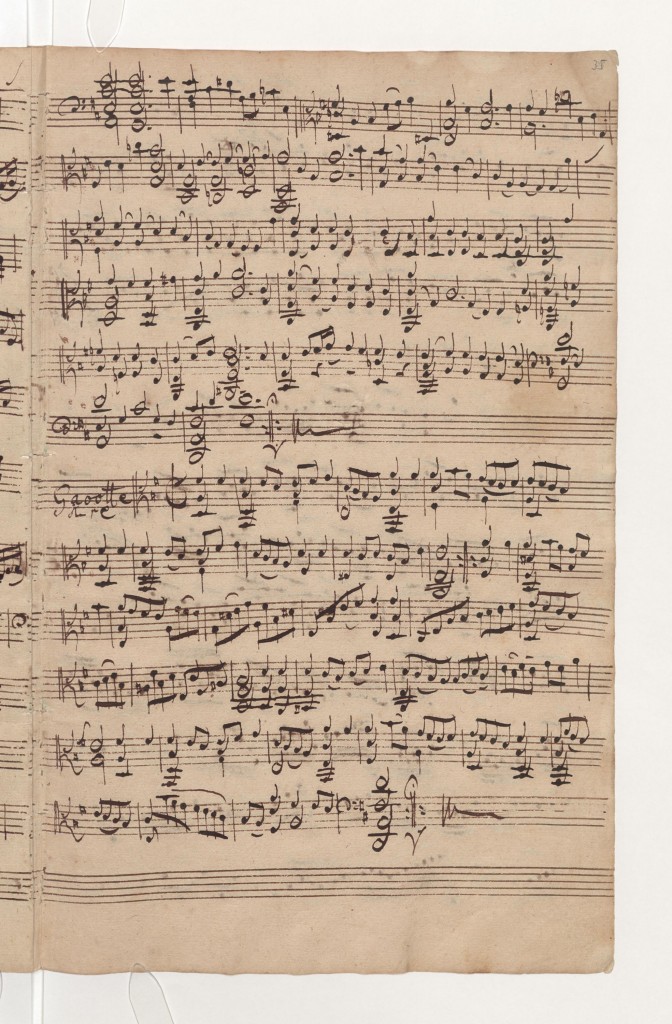
This is a translation of the post
Urtext = Klartext? – eine Analyse der Sarabande in D-Dur, Teil 2 (Takt 9-16)
by Dr. Marshall Tuttle
Michael Bach
This is the second part of the analysis of the
“Sarabande” in D Major
Guest:
Burkard Weber
Video:
Interpretation of “Sarabande in D Major”
Michael Bach, Violoncello with BACH.Bogen:
https://youtu.be/YuqXQgfPKkg

Copy of Anna Magdalena Bach, digital copy from the Staatsbibliothek in Berlin – PK
Part 2

Measure 9
We have 2 four-voice chords. I leave a note (E) out of the second chord, so I can take the G string. The second beat is also exceptionally emphasized.
Measure 10
Now comes: [plays the first beat time of measure 10] That could be the resolution, one could also imagine the relative minor, or one could imagine the mediant, depending on how it develops.
In the second beat one expects a D,
[plays up to the second beat of bar 10]
because we have again this cambiata motive. But Bach writes instead a D#. If such a thing sounds, we know, because of listening habits, that this is a secondary dominant, which probably resolves to E.
The only question is: in E minor or in E major?
[plays E major and then E minor]
At this point both would still be possible.
We know this, for example, from the G major suite: in bar 5, the relative key is E minor, and then after the dominant D major is again E minor as a deceptive cadence (bar 8), and suddenly a D# appears in bar 13 also, which would have to resolve again in bar 14 to E minor. The relative minor is even introduced here with its own secondary dominant.
Bach, in the Prélude, does something entirely different, namely, the opposite of what he does here in the Sarabande, he conceals the resolution: [plays the first half of bar 14 of the Prélude in G major]
This is not in any way a clear resolution, for example, something like this: [plays an arpeggiated E minor triad. These are tones of e minor,
[plays the first bar of bar 14]
but they remain trapped in this narrow tonal space, play around, and then lead to other harmonies.
Here, in the Sarabande D major, it is actually the case that Bach
[plays the first half of bar 10]
… and with the C we know it – will go to E minor. If Bach had written a C#, the target key would be E major.

Measure 11
In bar 11, Bach again brings the entire chord, the secondary dominant of E minor. And he even slurs the two eighth notes, that is, the second eighth note is unstressed. The eighth note G, which is also for E minor and not for E major, conceals Bach a bit (with a slur, the last note of which is always unstressed).
-------------------------------------------------------------------
This content is restricted to site members. If you are an existing user, please login. New users may register below.
Your " u s e r n a m e " can only contain < l e t t e r s > and < n u m b e r s >
and please < d o n 't > use < c a p i t a l > letters.
Your password will be sent to your email address immediately.
We will not share your email address with persons or organizations outside of the Atelier BACH.Bogen.
-------------------------------------------------------------------
Dieser Inhalt ist registrierten Nutzern vorbehalten. Wenn Sie bereits registriert sind, loggen Sie sich bitte ein. Wenn Sie noch nicht Nutzer sind, dann können Sie sich gerne registrieren.
Bitte geben Sie für den Nutzernamen ("username") < n u r > alphanumerische Zeichen (Buchstaben und Zahlen) ein und verwenden Sie < k e i n e > Großbuchstaben.
Ihr Passwort wird Ihnen per email umgehend mitgeteilt.
Wir halten uns an den Datenschutz.
-------------------------------------------------------------------
